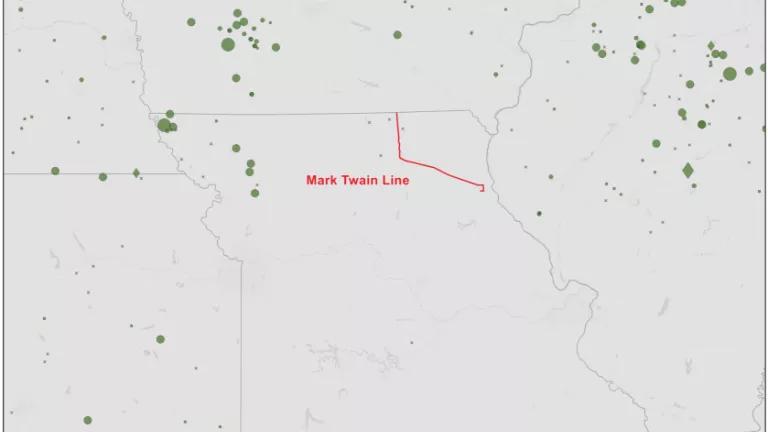Missouri: Mark Twain Creates Large Clean Energy Opportunity

Not our beloved author, the electric transmission project. The Missouri Public Service Commission (MoPSC) recently approved the construction of the Mark Twain transmission line which is expected to lower Missourians’ electricity bills, bolster wind and economic growth particularly in Northeast Missouri, and deliver cleaner air to in-state residents as well as those in neighboring states.
The favorable ruling also puts an end to a years-long quest by Ameren Transmission Company of Illinois (ATXI) to build the new transmission project connecting the South-East Iowa border to Northeast Missouri, and is the latest of a series of impressive steps forward on renewable energy that Missouri has undertaken in the past year (refer to my earlier blog for more on that).
Where and what is the Mark Twain line?
The Mark Twain project is a 345 kV transmission line to be built in Northeast Missouri by December 2019. It is also part of what is called the Midcontinent Independent System Operator (MISO) “multi-value portfolio”. In 2011, MISO- the grid operator for the Midwest region- identified a portfolio of 17 transmission projects distributed across its footprint that would increase the grid reliability and efficiency, help meet renewable energy goals in the region, and provide significant economic benefits that outweigh the portfolio costs. And the Mark Twain line is part of this portfolio.
The line holds exciting opportunities for Missouri and the region
Mark Twain is expected to deliver a suite of large economic and public health benefits for Missourians, further cementing the state’s position as a national clean energy leader. In fact, MISO estimates that the project’s benefits will be 2 to 3 times larger than its costs for Northeast Missouri!
First and foremost, Missourians can expect to pay lower electricity bills as a result of Mark Twain. Households and businesses will benefit from a net savings because of two factors.
One is that the new line will relieve transmission congestion in the region. Think about it this way—imagine that cars had to pay to drive on a highway. In situations of heavy traffic, the price to drive on the highway would be elevated compared with the price during low-traffic times in order to discourage cars from entering the highway. Now imagine that a new lane has been added to relieve the traffic—this would also have the effect of lowering the high prices during heavy traffic hours. This is what the Mark Twain line is expected to do. By relieving congestion on the grid, it will lower the prices that Missourians, and other residents in neighboring states, will be charged for electricity.
In addition, the Mark Twain line is expected to unlock large wind investments in Northeast Missouri (more on this in the second paragraph below). Considering that wind energy is now the cheapest form of new energy in many regions in the country—including Missouri—Mark Twain is expected to lower electricity prices by delivering low-cost wind power to residents in Northeast Missouri and beyond.
Mark Twain is also expected to boost the economy and public health in Missouri and surrounding states. Considering that Northeast Missouri enjoys copious wind resources, the line is expected to drive the development of up to 1,350 MW of wind projects in the area- that’s more than double the wind capacity currently operational in Missouri. Wind energy is a major job creator, and this wind expansion is no different. It is expected to create large employment opportunities for Missourians. In addition, the counties which will be crossed by the project will benefit economically from millions in tax revenues. The funds could be used towards improving county services, school districts and any development project that the counties see fit to invest in. Moreover, clean energy development is now increasingly becoming an attraction for commercial activity. Across the country, businesses are locating their facilities based on access to clean energy, bringing with them jobs and economic growth (stories of the sort can be found here, here and here). Thus, this is an opportunity to revitalize Northern Missouri by creating a fertile environment to attract businesses. And last, but certainly not least, by delivering large amounts of clean wind power to customers, Mark Twain will reduce the state and region’s need to rely on polluting fossil power. This will create important public health benefits for Missouri and the region driven by reductions in air pollutants like nitrogen oxides ("NOx"), sulfur dioxide ("SO2") and mercury.
Missouri: quickly becoming a major player in the clean energy revolution
The approval of the Mark Twain line is part of a series of impressive clean energy feats in Missouri. Ameren—the largest utility in the state and second-most coal reliant in the country—recently announced its gradual transition away from coal towards cleaner energy, cementing a major step forward for the state. In parallel, and on the Western side of the state, Kansas City Power & Light (“KCP&L) now generates 20 percent of its power from wind, while Empire District Company is proposing to close its one coal plant and tripling its wind investments. And with the Mark Twain line in place, Missouri will cement its position as a leader in the clean energy revolution. Hopefully, the benefits that the project will generate will inspire the approval of the Grain Belt Express transmission line—a project that would bring cheap wind energy from Kansas to Missouri, Illinois and beyond—which has repeatedly been blocked by a handful of Missouri counties (more on this here).
The approval of Mark Twain is a major step forward for the state, and will enable it to start capitalizing on its strategic location of being the gateway between the wind-rich West and demand centers of the East. On to more clean energy progress!

